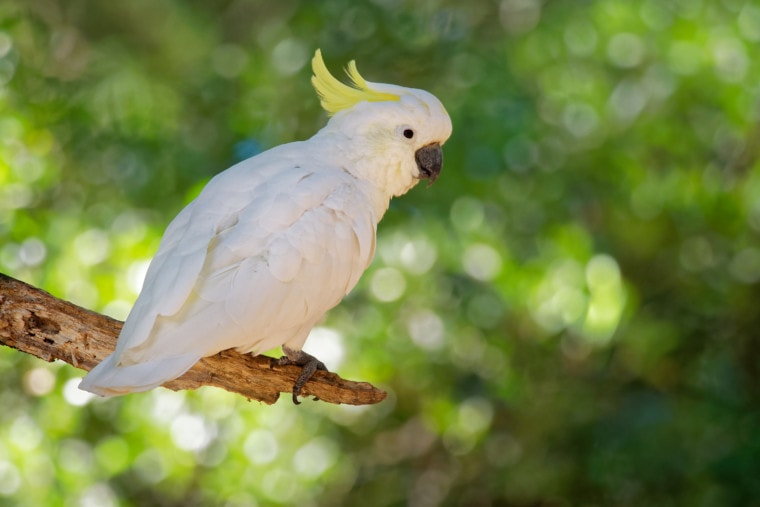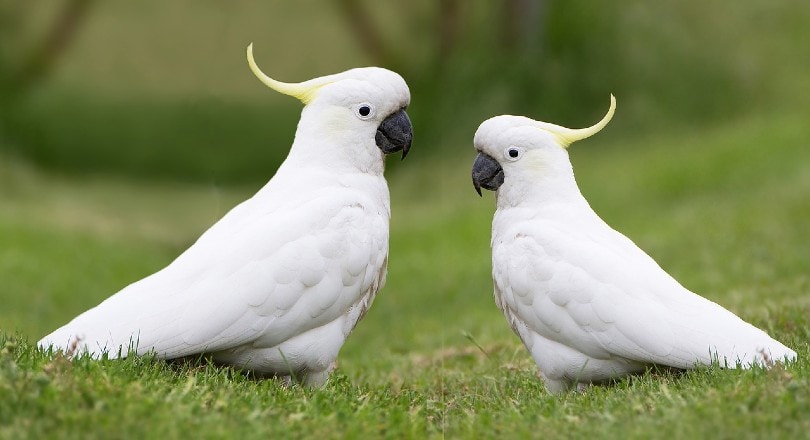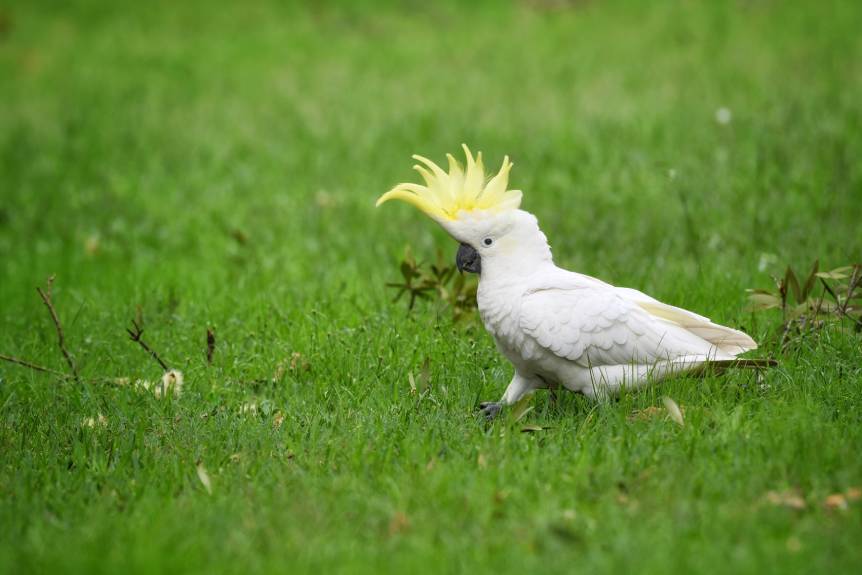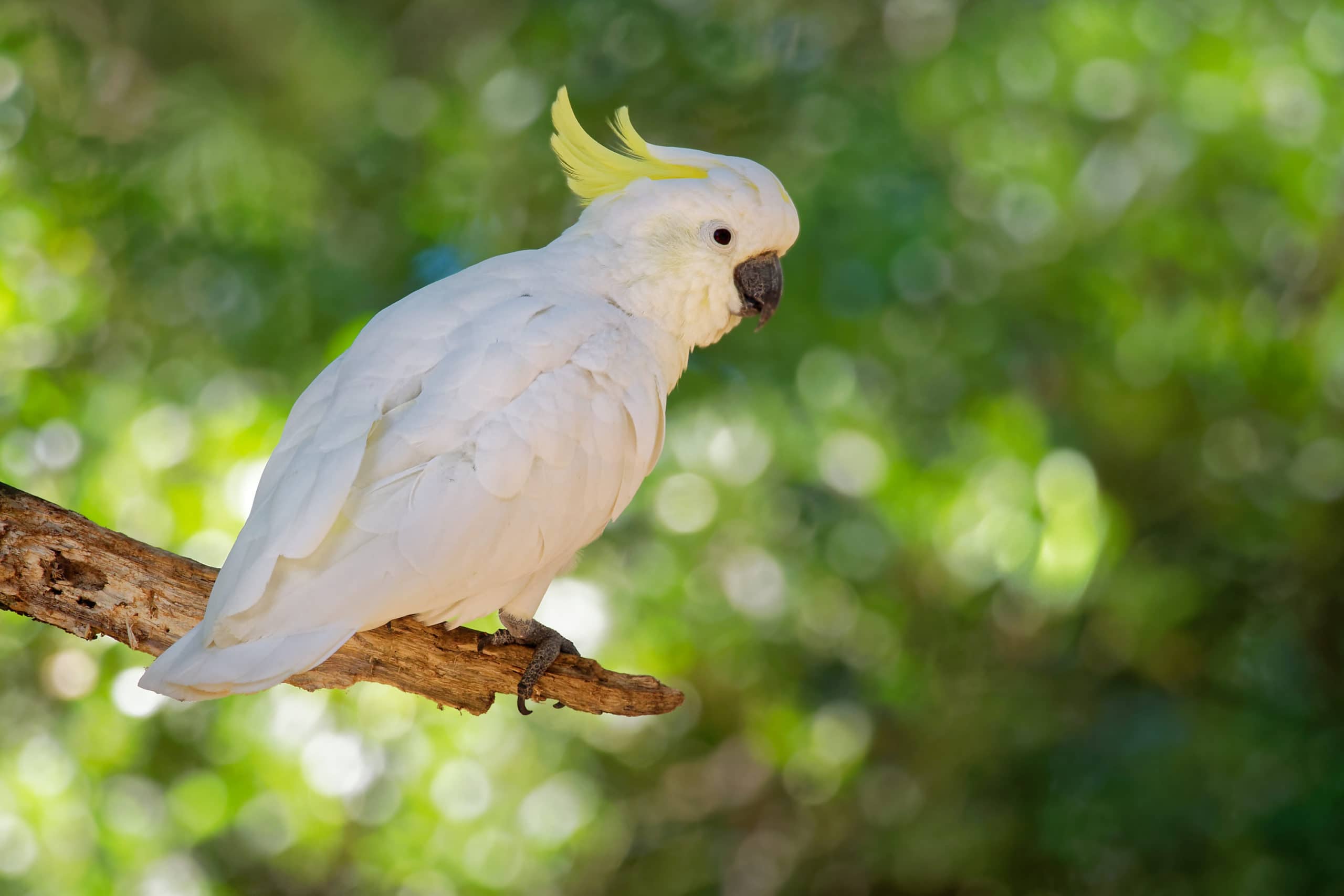
The yellow-crested Cockatoo is a medium-sized white cockatoo with a yellow crest. Also known as the lesser sulfur-crested Cockatoo, this bird has bluish-white bare skin, grey feet, a black bill, and its wings and tail are yellow on the underside.
This rare and endangered species is social and flies in large flocks over forested areas. Due to its appearance, this bird is often confused with the similarly-colored sulfur-crested Cockatoo, although they occupy different geographical ranges.
If you are considering getting this bird as a pet, here are the details about its temperament, physical appearance, exercise needs, and diet requirements.
Species Overview

| Common Name: | Yellow-Crested Cockatoo |
| Scientific Name: | Cacatua Sulphurea |
| Adult Size: | 13-15 inches |
| Lifespan: | 60 years |
Origin and History
The yellow-crested Cockatoo is native to the wooded and cultivated areas of East Timor and Indonesia’s islands of Sulawesi and the Lesser Sundas. These birds have also been introduced in Hong Kong and other parts of the world. Now the birds are confined to a few islands.
The population of this bird species has suffered a massive decline, estimated to be more than 80% in the past 40 years. Because of the deterioration, yellow-crested Cockatoos are classified as critically endangered. There are only a few remnant populations of related subspecies scattered around Indonesia.
With very few yellow-crested cockatoos remaining in the wild, these birds are exposed to a lot of threats. Like other animals found on Indo-Pacific islands, their major threats for survival include pet trade, habitat loss, unsustainable over-exploitation, and fragmentation.
Yellow-crested cockatoos inhabit the forest, forest edges, scrubs, and cultivated areas from sea level up to about 1500 meters.
Temperament
These adorable birds are curious and love to engage in activities. Yellow-crested Cockatoos are active and high-energy breeds. They make excellent pets because they are gentle, playful, and sometimes tend to be shy.
When you keep these lesser sulfur-crested Cockatoos, you need to keep in mind that they love to chew objects, although they are not as destructive as other cockatoos. To keep them occupied, you should provide them with toys, wood, or blocks they can chew.
These birds can’t talk properly; however, they can pick up some entertaining tricks if trained. You can also keep them in pairs; they get along well with fellow birds, and it’s suitable for companionship. Unlike the larger white Cockatoos and sulfur-crested birds, these bird species are not as demanding of your time or possessive.
Young yellow-crested Cockatoos should be socialized early to lots of situations, including toys, new cages, visits to the vet, strangers, and grooming sessions. When this is done early, they’ll have less anxiety and fear.
Speech and Vocalization
Unlike parrots, Cockatoos aren’t as prolific when it comes to talking. However, they have decent speech capabilities. Yellow-crested Cockatoos can mimic any sound and words.
Your bird’s ability to catch up on vocabulary depends on how much effort you put in. Their speaking ability depends on the species and how much training they receive.
Keep in mind that once the yellow-crested Cockatoo may scream the words, they have learned. They also make loud, screeching voices. Because of this, these birds are not well-suited for apartment living and are a noise nuisance.
The piercing shriek can be irritating and cause problems with your neighbors or visitors.

Yellow-Crested Cockatoo Colors and Markings
Lesser sulfur-crested Cockatoos are typically small white cockatoos with a yellow recurved crest. They are distinguishable from sulfur-crested Cockatoos by size and the presence of a large yellow ear patch. The underside of the flight feathers is usually yellow.
This underwing coloration and brightly colored crests are considered as a means of communication with flock mates. Like other birds of the same family, these parrots have zygodactyl feet, which allow them to jump from one tree branch to another.
Caring for the Yellow-Crested Cockatoo
Once you get your yellow-crested Cockatoo home, here are some of the things you need to do to take care of your bird.
Shelter
Yello-crested Cockatoos thrive in well-sized cages. They are active birds and, therefore, require a cage big enough for them to play, fly and jump around. Like other Cockatoos, these birds need a strong cage made of wrought iron or stainless steel; therefore, they can easily withstand the Cockatoo’s tough beak.
The horizontal bar wires are essential for your Cockatoo to exercise by climbing on the sides of the cage. These cages will be much smaller than the ones you get for a larger bird. To keep the birds stimulated, also provide some play toys and chew toys.
Compared to larger Cockatoos, lesser sulfur-crested birds are not such strong chewers. However, most of them can open the cage latches. To prevent your bird from escaping or getting out at the wrong time, it might be necessary to add locks or escape-proof latches. You could also add an outdoor cage to allow playtime in the fresh air and sunlight.
In addition, these birds are very social; hence they need companionship. If you are rarely at home, it’s best to get a second bird to keep your pet company. Otherwise, leaving them alone can push them to act out, and they can be very destructive.
Grooming
Grooming is very vital for these birds. Like other Cockatoos, these birds produce feather dust from their special powder-down feathers.
This fine dust can spread throughout your home and affect people with animal allergies. To reduce the spread of this dust, it’s advisable to bathe your bird at least once a week.
A regular bath or shower is vital in maintaining the bird’s skin condition and plumage. After the bath, you can dry them in a warm room, outside in the sun, or using a blow-drier. This will keep your bird clean at all times.
You should also trim your birds’ nails and wings when necessary. For the wings, care should be taken care of to ensure the feathers are not clipped excessively.
When clipping, focus on the primary flight feathers to allow the bird to glide on the floor. Yellow-crested Cockatoos that lose most of their wings will tend to fall and injure themselves.

Common Health Problems
Yellow-crusted Cockatoos are prone to health conditions that affect most Cockatoo species of the same size. Scheduling a routine check with your vet will minimize the risk of health complications and allow for early detection.
Let’s take a look at some of the most common diseases that these birds suffer from.
Psittacine Beak and Feather Disease
PBFD was first identified in various species of Cockatoos in the early 1970s. The medical condition is characterized by abnormal feather development and loss, beak deformities, leading to eventual death.
This viral disease is highly infectious and can be detected using DNA probes. The symptoms to look out for in your bird include loose feathers, dark patches on the feathers, beak lesions, and systemic infections.
Currently, there’s no effective therapy for this virus. Birds who get infected become prone to severe chronic conditions. However, with proper supportive care, they can survive for years. If your yellow-crested Cockatoo has this infection, it’s best to keep it isolated from other birds to prevent the spread.
Feather Picking
Feather picking in most pet birds is a frustrating experience for bird owners. Your yellow-crested Cockatoo could be engaging in this behavior due to various reasons.
For the vet to diagnose this condition, they have to analyze the history of your bird’s diet, housing, typical toys, and exposure to other animals. They might also need to carry out various blood tests and an analysis of feather samples and skin scrapings. Depending on the extent of the condition, they might also perform radiography, ultrasonography, or endoscopy.
Your bird might be plucking the feathers due to external parasites, fungal dermatitis, liver and kidney disease, intestinal infections, toxins, inadequate grooming, or psychological issues. After a complete analysis, the vet can advise on the best course of treatment.
Chlamydiosis
The bacteria-like organism Chlamydia psittaci causes this condition. It’s also known as psittacosis, parrot fever, and ornithosis. This condition can spread to people; therefore, it’s essential to avoid your bird if you have a susceptible immunity system.
The bacteria usually spread to people from an infected bird in its droppings or respiratory secretions. A bird will get infected by ingesting contaminated material or by inhaling the bacteria. The symptoms to watch out for include loss of appetite, weight loss, respiratory infections, and discharge from the eyes and nostrils.
Obesity
Like other birds, the yellow-crested Cockatoos are prone to obesity. This happens when the diet doesn’t include enough vegetables and fruits. To prevent your bird from becoming overweight, they also need to engage in enough physical activity daily.

Diet and Nutrition
In their natural habitats, yellow-crested Cockatoos feed on seeds, grain, and insects harvested from trees. However, in captivity, they need a varied diet that includes high-quality avian pellets, vegetables, and fresh fruits.
When feeding your pet bird, the pellets should make up 50 percent of the diet, while fresh vegetables, fruits, and grains should make up the rest. For treats, you can feed your pet bird seeds and seed mixes. These should be fed to your bird occasionally since they are high in fat. The same applies to nuts.
Adult and young lesser sulfur-crested Cockatoos are picky eaters and will utilize their calories efficiently. Therefore, ensure that the food they eat is nutritious. Your birds don’t require vitamin supplements if they are eating a formulated diet.
With nutrition, it’s best to monitor food intake to prevent obesity. If you overfeed your pet, it could lead to obesity, pickiness, wastage, and throwing food. Different bird sizes have different food needs.
For instance, yellow-crested Cockatoos are small, and you’ll need to gauge how much they are eating or throwing away. If your bird maintains a good weight, the feeding schedule is in order.
Exercise
These birds need some space for exercise. You have to provide cages big enough, fitted with ladders and perches for the bird to jump around and play.
Also, it would be best if you allowed the bird outside the cage once a day. To ensure their safety, this session should be supervised to protect them from flying outside the house or encountering dangerous items.
You can give the bird three to four hours daily for playtime outside the cage. During this period, ensure the window are secured.
In the cage, ensure your yellow-crested Cockatoo has chew toys such as tree branches, softwood toys, vegetable-tanned leather, rope toys, and cardboard. If you add hanging toys, check to ensure that they are secured and safe to don’t become a strangulation hazard.
Where to Adopt or Buy a Yellow-Crested Cockatoo
Like the sulfur-crested Cockatoo, this bird costs approximately $500-$2,000. Cockatoos are very popular birds; therefore, it’s easy to find them at a reputable breeder. The price at the breeders depends on the age of the bird, personality, and the breeder’s reputation.
Before taking a bird from the breeders, ensure you get information about their breeding and the specific bird. You can go a step further and take a tour of the facility to confirm that the birds are adequately cared for in clean cages and well-fed. In addition, you need to get a background history to know whether your bird has any potential medical conditions.
Apart from the breeder, you can also get a yellow-crested Cockatoo at a rescue or online sources from individual sellers. These alternatives might be much cheaper.
Final Thoughts
The yellow-crested Cockatoo is a playful, active, and intelligent bird. As one of the species in the cockatoo family, it’s become a popular pet bird thanks to its size and temperament. Keeping this bird requires minimal effort as long as you provide the proper diet and nutrition, grooming, exercise, and handle any arising health conditions.
This bird is a social bird and highly active. If well-socialized, it can co-exist with other birds and make a great companion pet.
Featured Image Credit: Martin Pelanek, Shutterstock










